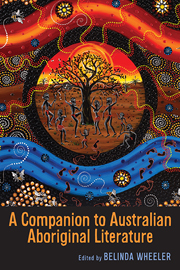Book contents
- Frontmatter
- Contents
- Foreword
- Acknowledgments
- Chronology
- Introduction: The Emerging Canon
- 1 Indigenous Life Writing: Rethinking Poetics and Practice
- 2 Australian Aboriginal Life Writers and Their Editors: Cross-Cultural Collaboration, Authorial Intention, and the Impact of Editorial Choices
- 3 Contemporary Life Writing: Inscribing Double Voice in Intergenerational Collaborative Life-Writing Projects
- 4 European Translations of Australian Aboriginal Texts
- 5 Tracing a Trajectory from Songpoetry to Contemporary Aboriginal Poetry
- 6 Rites/Rights/Writes of Passage: Identity Construction in Australian Aboriginal Young Adult Fiction
- 7 Humor in Contemporary Aboriginal Adult Fiction
- 8 White Shadows: The Gothic Tradition in Australian Aboriginal Literature
- 9 Bold, Black, and Brilliant: Aboriginal Australian Drama
- 10 The “Stolen Generations” in Feature Film: The Approach of Aboriginal Director Rachel Perkins and Others
- 11 A History of Popular Indigenous Music
- Notes on the Contributors
- Index
1 - Indigenous Life Writing: Rethinking Poetics and Practice
Published online by Cambridge University Press: 05 September 2013
- Frontmatter
- Contents
- Foreword
- Acknowledgments
- Chronology
- Introduction: The Emerging Canon
- 1 Indigenous Life Writing: Rethinking Poetics and Practice
- 2 Australian Aboriginal Life Writers and Their Editors: Cross-Cultural Collaboration, Authorial Intention, and the Impact of Editorial Choices
- 3 Contemporary Life Writing: Inscribing Double Voice in Intergenerational Collaborative Life-Writing Projects
- 4 European Translations of Australian Aboriginal Texts
- 5 Tracing a Trajectory from Songpoetry to Contemporary Aboriginal Poetry
- 6 Rites/Rights/Writes of Passage: Identity Construction in Australian Aboriginal Young Adult Fiction
- 7 Humor in Contemporary Aboriginal Adult Fiction
- 8 White Shadows: The Gothic Tradition in Australian Aboriginal Literature
- 9 Bold, Black, and Brilliant: Aboriginal Australian Drama
- 10 The “Stolen Generations” in Feature Film: The Approach of Aboriginal Director Rachel Perkins and Others
- 11 A History of Popular Indigenous Music
- Notes on the Contributors
- Index
Summary
Write of life
the pious said
forget the past
the past is dead.
But all I
see in front of me
is a concrete floor
a cell door
and John Pat.
—Jack DavisWhat does it mean to “write of life”? And how does Aboriginal writing position itself in relation to the politics of life itself? The opening stanza to Jack Davis's poem about sixteen-year-old John Pat, brutally beaten by police in 1983, troubles the relation between the Aboriginal custom of not speaking the name of the dead and the necessary task of memorializing such trauma. One way to read the stanza is to identify the pious as a double category: the pious may be those whites who insist Davis “forget the past”; yet, paradoxically, the pious may equally refer to those voices of tradition from within the Aboriginal community that insist upon maintaining the taboo against speaking the name of the dead. John Pat's death is a tragedy, like that of so many Aboriginal victims of Australia's (post)colonial inheritance of trauma and continued structural violence and systematic dispossession. Speaking Pat's name is not only tragic because of his death in police custody, on “a concrete floor / a cell door,” but also because of Davis's necessary compulsion to continue to speak his name and thereby break a traditional taboo.
- Type
- Chapter
- Information
- A Companion to Australian Aboriginal Literature , pp. 15 - 34Publisher: Boydell & BrewerPrint publication year: 2013



